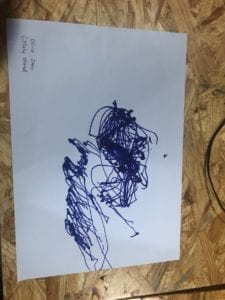Task
Step 1: Build the circuit
Schematic

Video
Process
The first step was very easy although it needed to be completed individually. I just connected the circuits and components according to the schematic. Despite the large number of circuits, I used different colors to differentiate them and checked again to make sure that I didn’t leave out anything.
Step 2: Control rotation with a potentiometer
Video
Process
The problem I met was the connection of potentiometer. Because I could’t remember whether it needs to be connected to the ground, so I turned to an assistant for help and recalled that it’s unpolarized. Then I added a map function to the former code but I’m not sure if it’s all, luckily, it worked.
Step 3: Build a Drawing Machine!
Video
Final Picture

Question
Why did my serial monitor display so slow?
Questions
1.I would be interested in building a thermostatic bottle which can keep the water temperature constant. The actuator it uses is a temperature regulator. After the temperature transducer senses the current temperature, it would be displayed on the screen. You can decide and input your targeted temperature, then the temperature regulator will start working. Moreover, the color of the bottle can change smoothly according to the current temperature of water. For example, blue for below 10 and red for above 50 and the middle will be purple using special material.
2. The art installation impressed me is Nicholas Stedman’s Blanket Project. When I see the blanket approaching the boy, somehow I feel moved. Compared to our drawing machine which only has one actuator, “the autonomous robotic blanket contains thirty-one motorized joints which allow it to assume many shapes, some optimized for movement and others for touching and stimulating people.” I think the artist selected these actuators because human beings’ movement can be diverse and irregular, so he used large amounts of different sensors and actuators.
Reference List
ART+Science NOW, Stephen Wilson (Kinetics chapter)